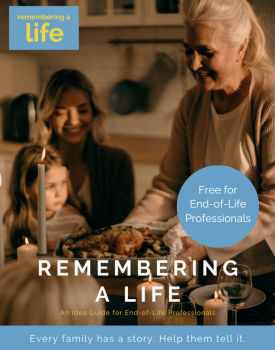
Create An Essence Tree
Symbolically, trees represent our growth and development through life. Roots are our foundation, the trunk our source of strength and power. Limbs represent our talents and abilities. And leaves are the many manifestations of our gifts, the results of flowering or producing in the world. The enduring beauty and stillness of trees invite us to absorb their essence so that we can gain understanding of who we are.
As a grief support activity, the essence of your relationship with your loved one and the essential elements of your loss experience – emotions, thoughts, physical sensations, change in circumstances and more - can find visual voice in the making of an essence tree. Your tree can be depicted realistically, metaphorically or symbolically, and the meaning conveyed as marks, lines, shapes, colors textures or images on any part of your art creation: background, roots, trunk, limbs or leaves.
Getting Started
There is no right or wrong way to make an essence tree. To get you started, here are some helpful suggestions and options.
Size
The size you choose to make your essence tree will depend on what you wish to express and the materials you choose. Some recommendations:
- 3’ x 6’ large/doorway size sheet of heavy duty paper or– wood, house wrap, cardboard, or canvas
- Small 18” x 24” sheet of heavy duty paper or – canvas if you are going to paint. Heavy duty paper is all that is needed if you are only going to use color markers, colored pencils or crayons. Some heavy paper will also allow for paint.
Materials
Materials can be layered in whatever way feels right to you; try and make choices based on whatever colors and materials you sense will best express the feelings, thoughts, and sensations you are experiencing in your grief. If you are new to creating expressive art, work in whatever medium – crayons, markers, pencils or paints – that seem most manageable.
- Your choice of coloring implements: acrylic paints; oil-based paint sticks; color markers; crayons; color pencils; glitter paints and glue
- Paint brushes: various sizes
- Optional embellishments ideas: stencils; glitter; any small objects that can be attached to your tree with strong glue
Steps for Creating Your Tree
Once you pick out your materials, think about the background and/or context within which your life is set and in which your loss has occurred, such as: history (traditions, meaningful experiences etc. that you shared with your loved one); environment (where your history with your loved one was shared); spirituality; and culture. The background of your tree can be filled in once your tree is completed, done as a first element on which to build other elements, or added to as you go – whatever feels right to you.
Step 1: Drawing the roots of your loss
Roots are symbolic of stability and being firmly established and can also represent blood relatives/ blood ties. When a loved one dies, it can feel as if the stable ground on which your life rested is now lost. Consider these questions as you draw or paint your roots:
- In what way am I/was I rooted to my loved one?
- What is at the root of my sense of loss?
- What does the establishment of new healthy roots look like?
Step 2: The trunk - drawing that which supports you
As a grief support activity, the trunk of your essence tree represents your core, your values, your vision and version of how you became you and what role your loved one played in that formation. The trunk is also symbolic of your strength – what holds you up, gets you through in difficult times.
Consider these questions, as you draw or paint your trunk:
- What are my strengths and how can those strengths aid me in processing and healing my grief?
- What are my core values and how can those values aid me in processing and healing my grief?
- What role did my loved one play in helping me form those strengths and values?
Step 3: Branches and leaves – reaching out
The branches and leaves of a tree cycle with the seasons of the year and life; buds emerge in spring and grow to fulfillment during summer, reaching out to accept the sun’s offered warmth and nourishment. In fall, leaves turn brilliant colors, and then fall. In winter, trees hibernate to rest and renew. Then in spring, the cycle begins again.
The branches of your grief essence tree reach outward, representing your need to reach out or accept help from others at this time, to express your grief, and to grow as your grief journey unfolds.
The leaves represent those people and things that are helping to lead you back to a sense of healing and wholeness.
Consider these questions, as you draw or paint your branches and leaves:
- What is the current season of my grief?
- What must I shed to move forward in my grief?
- Who and what is helping to nourish my growth and healing at this time?
- What continues to cycle through my life even in the midst of my loss?
To see essence tree examples, see Creating An Essence Tree on the Remembering A Life Blog.
Adapted from a workshop created and facilitated by Elizabeth Lewis, a certified grief support specialist, stress resilience teacher, spiritual counselor and motivational speaker. Elizabeth travels widely in the United States and Italy presenting talks and workshops on a wide variety of subjects including trauma healing, resilience-building, forgiveness facilitation, mindfulness, and healing art and writing. www.elizabeth-lewis-coach.com
